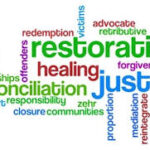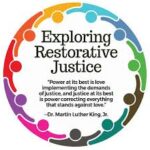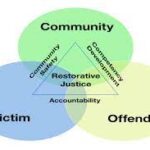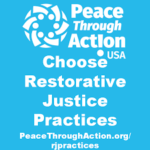Restorative Justice in the USA:
Transforming Justice Systems
Introduction

Restorative Justice (RJ) has emerged as a powerful alternative to traditional justice systems in many parts of the world, including the United States. Its principles, focused on repairing harm and rebuilding relationships, stand in contrast to punitive approaches that often perpetuate cycles of violence and recidivism. In this comprehensive exploration, we delve into the origins, principles, implementation, challenges, and successes of Restorative Justice in the USA.
Origins of Restorative Justice in the USA
Restorative Justice finds its roots in indigenous practices that prioritize healing, reconciliation, and community involvement in addressing harm. In the USA, the modern RJ movement gained momentum in the late 20th century as a response to the shortcomings of punitive justice systems, which disproportionately impacted marginalized communities and failed to address the underlying causes of crime.
One of the early milestones in the RJ movement in the USA was the establishment of the first victim-offender mediation program in Elkart, Indiana, in the 1970s. This program allowed victims and offenders to come together in a safe environment facilitated by trained mediators to discuss the harm caused, express their feelings, and negotiate restitution.
Principles of Restorative Justice

Restorative Justice is guided by several core principles:
Repairing Harm:
RJ focuses on addressing the harm caused by crime to individuals and communities. This entails acknowledging the needs and perspectives of both victims and offenders and working towards meaningful restitution.
Building Relationships:
RJ emphasizes the importance of fostering empathy, understanding, and accountability among all stakeholders involved in a crime. By facilitating dialogue and communication, RJ aims to repair and strengthen relationships.
Inclusion and Participation:
Restorative processes seek to involve all affected parties, including victims, offenders, and community members, in decision-making and problem-solving. This inclusive approach promotes a sense of ownership and collective responsibility.
Accountability and Responsibility:
RJ holds offenders accountable for their actions while also recognizing their potential for change and rehabilitation. It encourages offenders to take responsibility for repairing the harm they have caused and making amends.
Community Engagement:
Restorative Justice views communities as integral to the justice process. By engaging community members and resources, RJ seeks to address the underlying social, economic, and systemic factors that contribute to crime.
Implementation of Restorative Justice Practices

Restorative Justice practices encompass a range of interventions, including victim-offender mediation, family group conferencing, circle processes, and restorative circles in schools and workplaces. These practices can be implemented at various stages of the justice process, including pre-charge diversion, sentencing, and post-conviction.
One of the most widely used Restorative Justice practices in the USA is victim-offender mediation. In these mediated dialogues, victims have the opportunity to express the impact of the offense on their lives, ask questions, and seek restitution from the offender. Offenders, in turn, have the chance to take responsibility for their actions, apologize, and make amends.
Family group conferencing, another RJ practice, brings together the offender, victim, their respective supporters, and community members to discuss the offense and develop a plan for addressing the harm. This collaborative process empowers families and communities to take an active role in resolving conflicts and supporting healing.
Restorative circles, adapted from indigenous traditions, have gained popularity in schools and workplaces as a proactive approach to addressing conflict and building community. In these circles, participants sit in a circle and engage in structured dialogue facilitated by a trained circle keeper, promoting mutual respect, empathy, and understanding.
Challenges Facing Restorative Justice in the USA

Despite its promise, Restorative Justice faces several challenges in implementation and expansion in the USA:
Lack of Awareness and Understanding:
Many stakeholders, including justice professionals, policymakers, and the general public, may have limited awareness or misconceptions about Restorative Justice, hindering its adoption and acceptance.
Resource Constraints:
Implementing Restorative Justice programs requires adequate funding, training, and infrastructure. Limited resources may impede the scalability and sustainability of RJ initiatives, particularly in underserved communities.
Resistance from Traditional Justice Systems:
Restorative Justice challenges the entrenched practices and beliefs of traditional justice systems, which often prioritize punishment and deterrence. Resistance from within the justice system can pose barriers to the integration of RJ approaches.
Ensuring Equity and Inclusivity:
Efforts to promote equity and inclusivity within Restorative Justice processes must address power dynamics, cultural differences, and historical injustices. Ensuring meaningful participation and representation of marginalized communities is essential to prevent further harm.
Measuring Outcomes and Impact
: Evaluating the effectiveness of Restorative Justice programs requires robust data collection, outcome measurement, and research. Developing standardized metrics and methodologies for assessing the impact of RJ on recidivism, victim satisfaction, and community safety remains a challenge.
Successes and Impact of Restorative Justice

Despite these challenges, Restorative Justice has demonstrated promising outcomes and transformative potential in the USA:
Victim Satisfaction and Healing:
Research indicates that victims who participate in Restorative Justice processes report higher levels of satisfaction, closure, and emotional healing compared to those involved in traditional court proceedings.
Reduced Recidivism:
Several studies have shown that Restorative Justice interventions are associated with lower rates of reoffending among participants, suggesting that addressing underlying needs and repairing harm can break the cycle of crime.
Community Empowerment:
Restorative Justice fosters community engagement, resilience, and social cohesion by involving stakeholders in decision-making and problem-solving. Communities that embrace RJ principles are better equipped to address conflict and promote restorative practices.
Cost-Effectiveness
: Restorative Justice programs have been found to be cost-effective compared to traditional justice approaches, as they reduce the burden on courts, prisons, and other institutional systems while addressing the root causes of crime.
Cultural and Healing Practices:
Restorative Justice honors diverse cultural traditions and healing practices, recognizing the importance of indigenous wisdom and community-based solutions in addressing harm and promoting reconciliation.
Conclusion

Restorative Justice represents a paradigm shift in how societies respond to crime, emphasizing healing, accountability, and community involvement. While the implementation of RJ practices in the USA faces challenges, its successes in promoting victim satisfaction, reducing recidivism, and empowering communities underscore its potential to transform justice systems. By embracing Restorative Justice principles and practices, the USA can move towards a more equitable, compassionate, and effective approach to addressing harm and building safer, more resilient communities.


